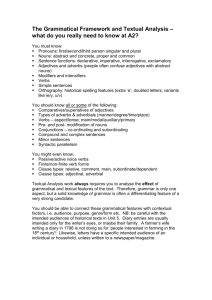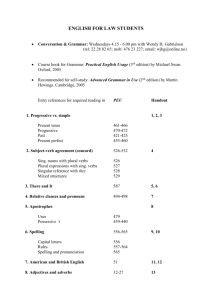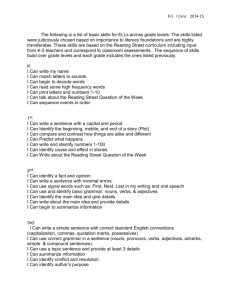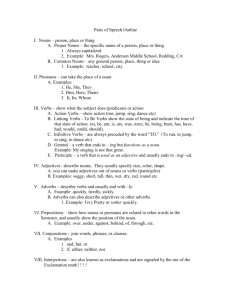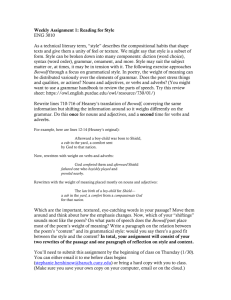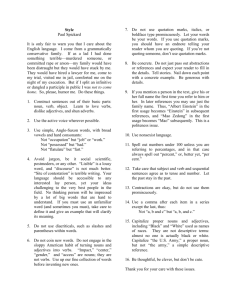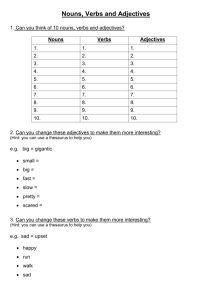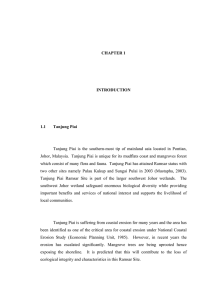Teaching Literature in the ESL classroom
advertisement
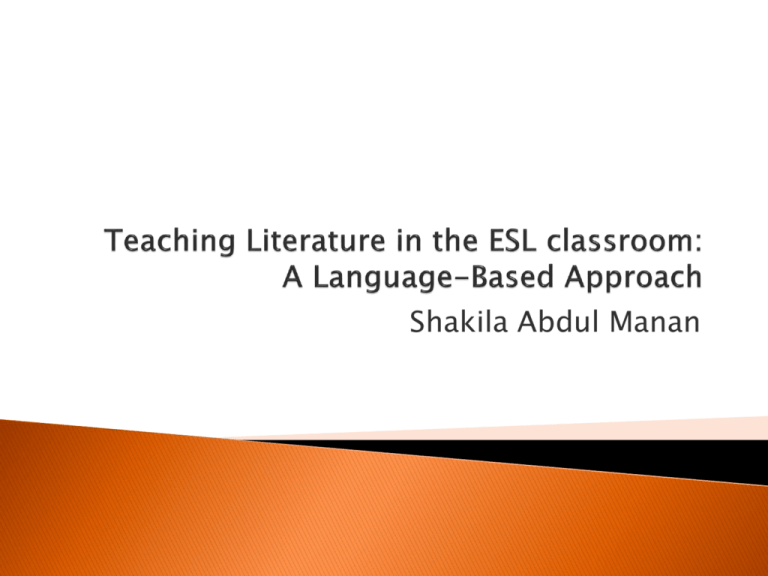
Shakila Abdul Manan Malaysia Education Blueprint (2013-2015) Equip our students holistically to allow them to succeed in the 21st century. Develop young Malaysians who can think critically and creatively. Making it compulsory for students to pass the English SPM paper from 2016. Provide students with greater exposure to the language, for example via an expanded, compulsory literature in English module at the primary and secondary level. Form 4 – 5 1. POEMS A Poison Tree – Selected by : Pie Corbett and Valerie Bloom Selected poems: FORM 4 1. Living Photograph – Jackie Kay 2. Charge of the Light Brigade – Tennyson FORM 5 1. A Poison Tree – William Blake 2. What Happened to Lulu? – Charles Causley 2. SHORT STORY i. Leaving No Footprint – Stories from Asia Retold by Kay West ii. Changing their skies – Stories from Africa 3.DRAMA i. Five Short Plays – Oxford University Press FORM 5 (starting 2016) 1. NOVEL i. Dear Mr Kilmer – Anne Schraff ii. Captain Nobody – Dean Pitchford iii. Sing To The Dawn – Minfong Ho Using linguistics to study literary texts. ESL students lack the necessary intuitive or interpretive skills to understand literary texts. However, they can be taught the form and structure of words, clauses, paragraphs and discourse. A text is a linguistic construct and we process it as a linguistic construct before anything else. Literary competence if not “caught” can be “taught” in the ESL classroom. Leaving No Footprint: Stories from Asia (Retold by Clare West) “Tanjung Rhu” by Minfong Ho. Suggested Activities Set Induction (to stimulate response and a willingness to respond). Do you like to read stories? Is there a story that you like very much? Would you like to share this story with the class? Who is Minfong Ho? Where was she born? What are some of the books that she has written? Where is Tanjung Rhu? What are some of the elements of a short story? What are nouns, verbs, adjectives, adverbs, prepositions etc? Setting: time and place of the events in a story: nouns (“house”; “garden”), adjectives (“big”; “empty rooms”), prepositions (“under the bridge”), adverbs of time (“now”, “yesterday”), place (“here”, “there) etc. Functions: determines character and events and suggests theme determines how people live their lives affects and shapes responses to life evokes atmosphere (overall mood or feel of a story) through an author’s description of time and place. “The day after his mother was buried, Mr. T. W. Li stood for a long time looking out of his window high above Shenton Way. Below him, sunlight fell on the oily water of Singapore harbour. He could hear the noise of the heavy traffic in the distance (Tanjung Rhu, p. 18)… “He was boyishly eager to show her the binoculars, the evening he returned home from work with them. The driver had only just stopped the Mercedes Benz, when Mr Li jumped out. Pushing past the servant at the door, he hurried towards the back of the house, walking past room after room looking for his mother. He was proud of the house, but he always had the feeling that there were too many empty rooms in it, and most of them too big. In one of the rooms he saw his wife Helen, having tea with a handful of her friends, He disliked these teas of hers, with the women’s soft voices, the smell of perfume, the cakes made with expensive foreign fruit… …He found his mother beside the swimming pool in the garden, where she was feeding her chickens. She was small and thin, with grey hair and a bent back (Tanjung Rhu, 1920). Questions Which social class do the characters belong to? Pick out the nouns and adjectives that help you to say so. How does the setting relate to the story’s theme? Writers do not tell us what a character is like. Neither do they tell us how we should think of him/her. How are characters revealed in a story? Physical description: features, gestures, mannerisms, voice and how they dress (look out for nouns, adjectives, adverbs). Eg: “He Mr Li kept his hair carefully dyed black, except for a little grey. He hoped this made him look like a man who had inherited his money, not earned it” (Tanjung Rhu, p. 19). Comment: Mr Li is ashamed of his humble beginnings. Dialogue: how a character feels or thinks through what s/he says or what others think and say about her/him (adjectives and verbs of perception, feelings and cognition or stative verbs for example “appear”, “believe”, “love”, “seem” etc). Actions: how a character acts and responds to conflicts/ challenges/new situations (verbs and adverbs). Thoughts and feelings: how characters think of themselves (stative verbs). “Ah-Ma, he began, then stopped. Quickly he looked at the doorway and checked that there was no one there. Then he bent his head and shoulders and bowed deeply, once twice, three times. Some joss sticks, he thought. I should light some joss sticks. He went to the desk. One by one he pulled the drawers open, but he could find no joss sticks” (Tanjung Rhu, p. 35). Question What do the actions reveal about Mr. Li’s character? Angle from which a story is told or recounted. The point of view may be the author’s, narrator or a character of a story. Examples of different points of view: Omniscient or third person point of view (use of third person pronouns: “he”, “she”, “they” ). Third person limited point of view (use of third person pronouns: “he”, “she”, “they” but the narrator intrudes into the consciousness of particular characters only). First person point of view (use of first person pronouns: “I”, “we”, “me”, “mine”). Stream of consciousness (prolonged use of verbs of perception, feelings and cognition). “Suddenly he wanted, more than anything in the world to go back to that time when he was a little boy growing up in Tanjung Rhu. He wanted to see the fishing boats sailing into Tanjung Rhu in the early evening, the wind catching their sails. Closer at home, there was always the smell of salt and fish and rice cooking over wood fires. And yes, he remembered the feel of the sand on the beach between his toes, and the coldness of seaweed around his ankles” (Tanjung Rhu, p. 30). Question: From whose point of view is the story being told? From what point of view is the story being told? Theme refers to the story’s underlying message, or 'big idea.' In other words, what ideas/beliefs/perception about life is the author trying to convey through the story or poem? It transcends cultural barriers as it is usually universal in nature. It will revolve around life and human experiences (love, friendship, honesty, war, poverty etc). Often, a story or poem may have more than one theme. Theme is revealed through title, key phrases or statements about big ideas, the way characters change and learn about the lessons of life. It is not directly presented but one can infer the theme through the characters, action, and setting that make up the story. The theme is not the topic but the point that is made by the author about the topic. It teaches you a valuable lesson about life. “What does it matter? Come on, Popo, just let me do it. She noticed her father in the doorway and gave him a secret smile. Softly, in English, she said to him, “Sorry, this is going to take a long time!”. Then, in Cantonese, she said to her grandmother, “Grandfather would probably like to hear from me for a change. You’re the only one who talks to him”. “Do you even know how to speak to your grandfather in the right way? And afterwards, what candles do you light, what wine do you offer? Do you know? Ying sighed deeply. “It doesn’t matter. My father’s waiting for you. You’ll make him late for work.” “Tell your father”, the old lady said, “that his father is waiting for me.” Ying whispered to her father in English, “She just won’t hurry, Baba. Always has to do just what she wants!” Mr Li frowned. She should not speak like that about her grandmother, he thought. Children these days have no respect for their elders. Aloud, he said in Cantonese, “Your grandmother is old. She has eaten more salt than you have eaten rice.” (Tanjung Rhu, p. 26). “The man in the photograph looked down at him, his face smooth and ageless. When he died, he was ten years younger than Li was now. Suddenly Mr Li wanted to speak to his father again, the way he used to, talking away in quick Cantonese, his words only just keeping up with his steps as he ran alongside his father. But now, the words would not come, and his father was gone. So he stayed silent, waiting as his mother slowly put everything away in her desk and locked up the drawer (Tanjung Rhu, p. 27). Question Identify one theme in the above extracts. THANK YOU
